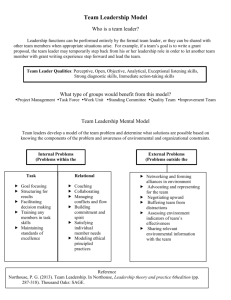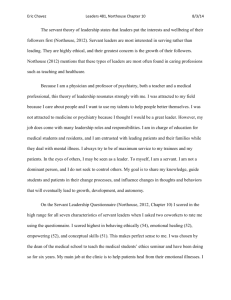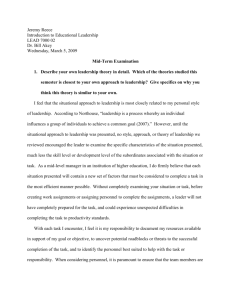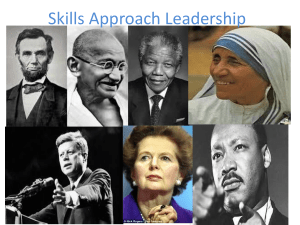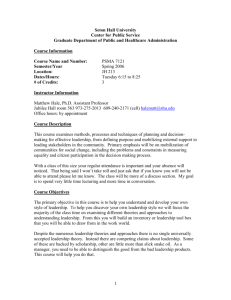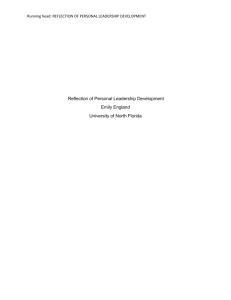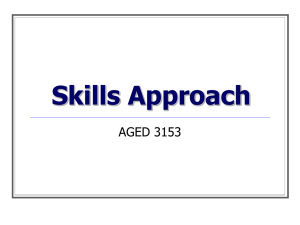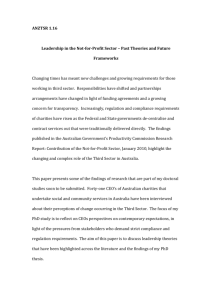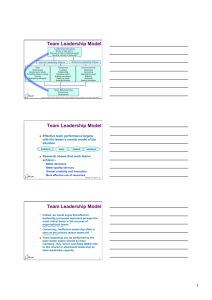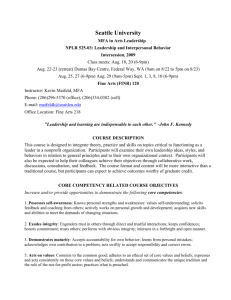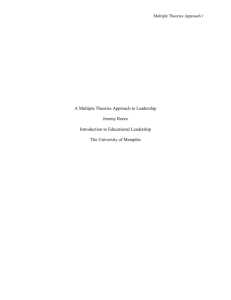leadership theory analysis
advertisement
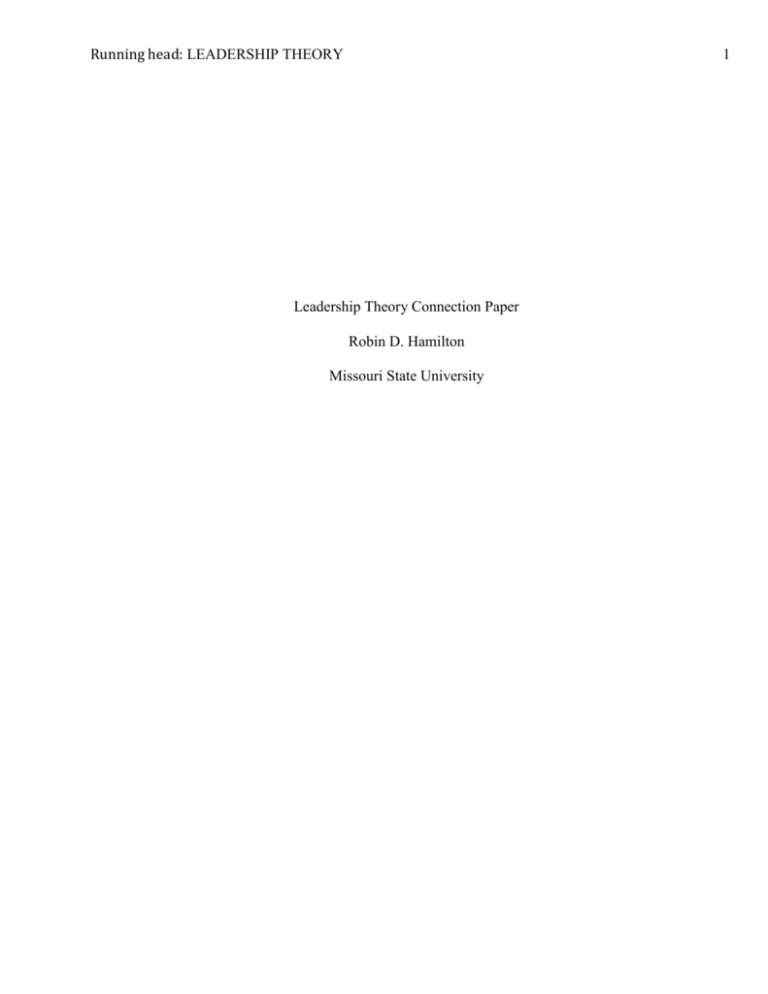
Running head: LEADERSHIP THEORY 1 Leadership Theory Connection Paper Robin D. Hamilton Missouri State University 2 LEADERSHIP THEORY Introduction Leadership can arguably be the most unique and complex term to define and explain, because there are several styles, approaches, and theories to consider. This paper will describe and analyze the Skills Approach, which is one of many leadership theories. It will compare and contrast the Skills Approach to other theories, and illustrate its application by describing a leader within a higher education setting who has a leadership style using the Skills Approach. Leadership Theory Synthesis According to Northouse (2013), the Skills Approach leadership theory “takes a leadercentered perspective on leadership” (p. 43), and “suggests that knowledge and abilities are needed for effective leadership” (p. 43). Individuals who operate using this theory typically have leadership skills that can be defined “as the ability to use one’s knowledge and competencies to accomplish a set of goals or objectives” (Northouse, 2013, p. 44). However, if it is determined that the leader does not have knowledge or competence in an area, the Skills Approach suggests that the leader can be taught any skills or abilities needed to be effective (Northouse, 2013). The driving force that provided momentum for the Skills Approach came from Robert Katz’s 1955 Harvard Business Review article entitled, “Skills of an Effective Administrator.” Prior to this article being written and published, there was research completed that discussed leadership concepts, theories, styles, and/or approaches. One in particular being the Trait Approach that focused on a leader’s innate personality characteristics, which will be discussed later in this paper. Nonetheless, with research being done at this time to identify what types of traits were found in leadership in general, Katz’s article had a goal to provide a different perspective (Northouse, 2013). Katz attempted “to transcend the trait problem by addressing leadership as a set of developable skills” (Northouse, 2013, p. 43). Katz’s research determined LEADERSHIP THEORY three administrative skills sets that an effective leader could possess. These basic skills included technical, human, and conceptual skills, and are one of two parts to the Skills Approach theory. The latter portion of this theory is the Skills Model developed by Mumford during the 1990s (Northouse, 2013). In short, Northouse (2013) explains Katz’s technical skills involving hands-on activity for the leader, and that the leader has “knowledge about and proficiency in a specific type of work or activity” (p. 44). In an organizational setting (e.g. higher education), leaders with technical skills typically have supervisory and middle management roles, which is where these skills are more vital. Additionally, Katz’s second basic skill set, human skills, is also vital at the supervisory level and middle management levels, in addition to top management levels. These human skills can be defined as “knowledge about and ability to work with people” (p. 44). It is also having the “abilities that help a leader work effectively with subordinates, peers, and superiors to accomplish the organization’s goal” (p. 45). Leaders possessing human skills typically value employees being able trust, depend, and feeling included in the areas that they could be affected. These leaders take into account the employees when making decisions (Northouse, 2013). Lastly, Katz’s conceptual skills are suggested to be more important at the middle and top management levels of an organization. At these levels, conceptual skills are the ability for the leader to work with ideas and concepts. For example, leaders who utilize conceptual skills typically work well with abstractions and hypothetical scenarios; creating a vision and/or a strategic plan for organizational policy and functioning would be easy for these leaders (Northouse, 2013). The second part of the Skills Approach theory is the Skills Model developed by Mumford and others. This model is known as a capability model, and “examines the relationship between 3 LEADERSHIP THEORY a leader’s knowledge and skills (i.e. capabilities) and the leader’s performance” (Northouse, 2013, p. 47) for effective leadership. Northouse (2013) describes the model in five areas, which are competencies, individual attributes, leadership outcomes, career experiences, and environmental influence. The competencies area, which is the heart of the Skills Model, includes problem-solving, social judgment, and knowledge skills. Each of these competency skills “are the key factors that account for effective performance” (p. 48). Individual attributes “support people as they apply their leadership competencies” (p. 52). These attributes include general cognitive ability, crystallized cognitive ability, motivation, and personality. Finally, leadership outcomes “increase chances of problem solving and overall performance” (p. 53) within an organization. Career experiences can be described as encompassing individual attributes and competencies; the aforementioned areas and purposes. These experiences assist leaders in overall improvement of knowledge and skills as they move throughout their career. Environmental influences “represent factors that lie outside the leader’s competencies, characteristics, and experiences” (Northouse, 2013, p. 56), and can be categorized as internal or external. Both career experiences and environmental influences, in addition to individual attributes, competencies, and leadership outcomes help leaders who embrace the Skills Approach and become effective leaders and problem solvers (Northouse, 2013). Skills Approach: Compare and Contrast Northouse (2013) states “skills are what leaders can accomplish, whereas traits are who leaders are (i.e. their innate characteristics)” (p. 44). This explanation helps provide a framework of how the Skills Approach theory differs from Trait Approach in that the Trait theory emphasizes that individuals can be born with special characteristics. These characteristics are 4 5 LEADERSHIP THEORY suggested to play a role in making the individual who possess them be a great leader; additionally, the characteristics “usually are viewed as innate and largely fixed” (Northouse, 2013, p. 43). However, even with the Trait Approach focusing on leader’s innate personality characteristics, and the Skills Approach emphasizing that knowledge and abilities can be taught to leaders, both theories are similar in that they are leader-centered. Each of these approaches benefits those who are in power or in a leadership role, rather than the followers of these leaders. The Servant Leadership Approach, however, “emphasizes that leaders be attentive to the concerns of their followers, empathize with them, and nurture them” (Northouse, 2013, p. 219). Unlike the Skills Approach, servant leadership addresses the followers’ (e.g. employees’) needs first, before their own. Northouse (2013) describes the Servant Leadership Approach as being a form of common sense and should be a natural feeling for leaders to empower those who follow them. Nonetheless, a similarity between Servant Leadership and the Skills Approach is that each has the skills and capabilities to motivate those individuals who they lead, and has an awareness of the environment and how it impacts performance. Leadership Theory Application A higher education leader who demonstrates leadership using the Skills Approach is Tracey Glaessgen. Tracey is the Assistant Director for First-Year Programs at Missouri State University, and serves as a middle management leader in the department. She is in charge of overseeing and facilitating trainings for new instructors, graduate assistants, and peer leaders, in addition to maintaining the positive office morale. Tracey is able to effectively fulfill these responsibilities by making a continuous effort to communicate with the director on a daily basis. When the director has a new idea for the development of the department, Tracey takes his ideas 6 LEADERSHIP THEORY and shares it with those individuals who are at the supervisory management level (e.g. graduate assistants). Her open and constant communication in person, via email, and over the phone illustrates her strong human leadership skills and her approach to ensuring that she is assisting all members of the department to achieve a common goal. Because Tracey is in a middle management, she is also effective in balancing her technical skills and conceptual skills. She creates sample lesson plans and syllabi for graduate assistants, but also has an important role by serving on advisory boards (e.g. university common reader program) for the director and makes decisions on behalf of the department. When analyzing Tracey’s strengths as it relates to the Skills Approach, she is more effective in the human skills area and has the ability to have others trust her easily. She demonstrates characteristics in the Skills Model by being able to listen to graduate assistants’ concerns and relaying this information to the director. When possible, Tracey uses her knowledge and experiences she has learned and developed over time and effectively solves problems on behalf of the director. Her ability to be proactive and make decisions for the department, create innovative ideas for office morale (e.g. birthday celebrations for members of the department), and produce tangible products (e.g. meeting agendas) illustrates her leadership using the Skills Approach. Tracey’s knowledge and capabilities is a necessity for the functioning of the department, and adds to the outcome of effective and positive performance. Conclusion There is much more to be said about the Skills Approach, its inception, emphasis, and how it is structured in the world of leadership theories. Strengths of this approach can enhance leaders, but there are other characteristics that can work to create an even better leader. 7 LEADERSHIP THEORY References Northouse, P. G. (2013). Leadership: Theory and practice (6th ed.). Thousand Oaks, CA: Sage.
